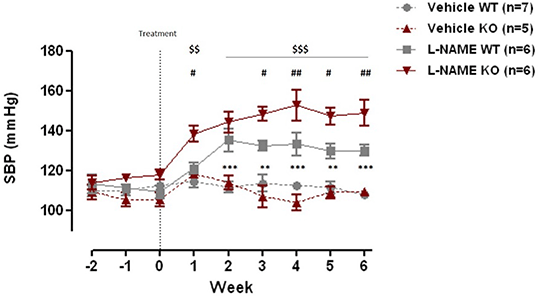| 157P London, UK Pharmacology 2016 |
α-Calcitonin gene-related peptide protects the vasculature in L-NAME-induced hypertension
Introduction α-Calcitonin Gene-Related Peptide (αCGRP) is a potent vasodilator neuropeptide that has recently been shown to be protective in AngII-induced hypertension (1). The current study aimed to characterize the L-NAME-induced experimental model of hypertension and elucidate whether αCGRP's protective mechanism involves nitric oxide.
Method All in vivo procedures were carried out in accordance to the UK Home Office Animals (Scientific Procedures) Act 1986. Age-matched adult male C57BL/6J wild type (WT) and αCGRP knock-out (KO) mice were used to obtain baseline values of systolic blood pressure (SBP) non-invasively via tail-cuff plethysmography(1), prior to being randomly assigned to receive L-NAME (1mg/ml, Sigma) in their drinking water for 6 weeks. Control groups received tap water. Upon termination; aortic tissues were fixed in 4% paraformaldehyde, processed and embedded in paraffin before 5µm sections were cut and stained with Masson’s trichrome to assess vascular remodelling1. Data is expressed as mean±SEM (n=5-6) and analysis was performed using two-way ANOVA followed by Bonferroni post hoc test.
Results All mice were normotensive at baseline, and the vehicle treated mice maintained normal SBP throughout the study. 2 weeks of L-NAME treatment induced hypertension in WT mice which was found to be statistically significant from vehicle treated WT mice. The αCGRP KO mice developed an increase in SBP, a mean of 138.5 ± 3.9 mmHg, after only one week of receiving 1mg/ml L-NAME treatment which was found to be significantly different (p<0.05) to its WT counterpart (121.2 ± 2.7 mm Hg) and this continued from Weeks 3 to 6.
Conclusion Chronic treatment with L-NAME induced exacerbated hypertension in αCGRP KO mice suggesting that αCGRP played a protective role in the L-NAME treated WT mice. Unlike the AngII-induced model, L-NAME treatment did not lead to an increase in heart mass or vascular remodelling in the aorta. However, cell biology profiling remains to be implemented. In conclusion, this study established a model of hypertension and provided novel data supporting an NO-independent protective role of αCGRP, which is distinct from its role previously shown with AngII.

Figure 1 - Effect of 1mg/ml L-NAME treatment on WT and αCGRP KO mice. Mean ± S.E.M. **p<0.01, ***p<0.001 for WT vehicle treated mice vs WT L-NAME treated mice, $$p<0.01, $$$p<0.0001 for αCGRP-KO vehicle treated mice vs αCGRP-KO L-NAME treated mice, #p<0.05, ##p<0.01 for αCGRP-KO L-NAME treated mice vs WT L-NAME treated mice.
References
(1) Smillie SJ et al. (2014). Hypertension 63(5): 1056-1062.

